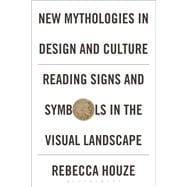New Mythologies in Design and Culture Reading Signs and Symbols in the Visual Landscape

New Mythologies in Design and Culture Reading Signs and Symbols in the Visual Landscape
- ISBN 13:
9780857857620
- ISBN 10:
0857857622
- Format: Paperback
- Copyright: 05/19/2016
- Publisher: Bloomsbury Academic
Note: Supplemental materials are not guaranteed with Rental or Used book purchases.
Extend or Purchase Your Rental at Any Time
Need to keep your rental past your due date? At any time before your due date you can extend or purchase your rental through your account.
Summary
Taking as its point of departure Roland Barthes' classic series of essays, Mythologies, Rebecca Houze presents an exploration of signs and symbols in the visual landscape of postmodernity. In nine chapters Houze considers a range of contemporary phenomena, from the history of sustainability to the meaning of sports and children's building toys. Among the ubiquitous global trademarks she examines are BP, McDonald's, and Nike. What do these icons say to us today? What political and ideological messages are hidden beneath their surfaces? Taking the idea of myth in its broadest sense, the individual case studies employ a variety of analytic methods derived from linguistics, psychoanalysis, anthropology, sociology, and art history. In their eclecticism of approach they demonstrate the interdisciplinarity of design history and design studies.
Just as Barthes' meditations on culture concentrated on his native France, New Mythologies is rooted in the author's experience of living and teaching in the United States. Houze's reflections encompass both contemporary American popular culture and the history of American industry, with reference to such foundational figures as Thomas Jefferson and Walt Disney. The collection provides a point of entry into today's complex postmodern or post-postmodern world, and suggests some ways of thinking about its meanings, and the lessons we might learn from it.








